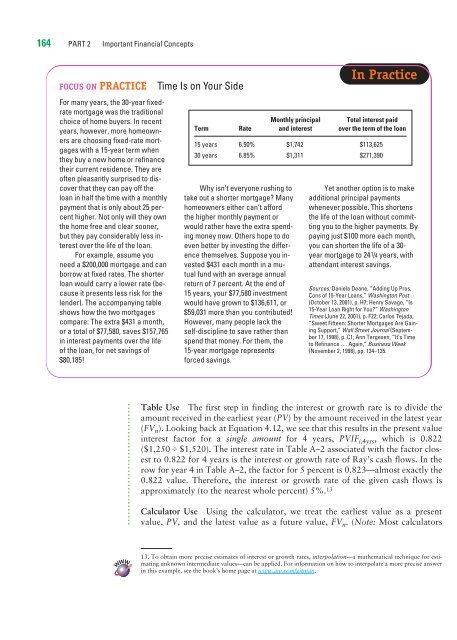Read the Chapter 4 E-Book
Read the Chapter 4 E-Book
Read the Chapter 4 E-Book
Create successful ePaper yourself
Turn your PDF publications into a flip-book with our unique Google optimized e-Paper software.
164 PART 2 Important Financial Concepts<br />
FOCUS ON PRACTICE Time Is on Your Side<br />
For many years, <strong>the</strong> 30-year fixedrate<br />
mortgage was <strong>the</strong> traditional<br />
choice of home buyers. In recent<br />
years, however, more homeowners<br />
are choosing fixed-rate mortgages<br />
with a 15-year term when<br />
<strong>the</strong>y buy a new home or refinance<br />
<strong>the</strong>ir current residence. They are<br />
often pleasantly surprised to discover<br />
that <strong>the</strong>y can pay off <strong>the</strong><br />
loan in half <strong>the</strong> time with a monthly<br />
payment that is only about 25 percent<br />
higher. Not only will <strong>the</strong>y own<br />
<strong>the</strong> home free and clear sooner,<br />
but <strong>the</strong>y pay considerably less interest<br />
over <strong>the</strong> life of <strong>the</strong> loan.<br />
For example, assume you<br />
need a $200,000 mortgage and can<br />
borrow at fixed rates. The shorter<br />
loan would carry a lower rate (because<br />
it presents less risk for <strong>the</strong><br />
lender). The accompanying table<br />
shows how <strong>the</strong> two mortgages<br />
compare: The extra $431 a month,<br />
or a total of $77,580, saves $157,765<br />
in interest payments over <strong>the</strong> life<br />
of <strong>the</strong> loan, for net savings of<br />
$80,185!<br />
WWW<br />
In Practice<br />
Monthly principal Total interest paid<br />
Term Rate and interest over <strong>the</strong> term of <strong>the</strong> loan<br />
15 years 6.50% $1,742 $113,625<br />
30 years 6.85% $1,311 $271,390<br />
Why isn’t everyone rushing to<br />
take out a shorter mortgage? Many<br />
homeowners ei<strong>the</strong>r can’t afford<br />
<strong>the</strong> higher monthly payment or<br />
would ra<strong>the</strong>r have <strong>the</strong> extra spending<br />
money now. O<strong>the</strong>rs hope to do<br />
even better by investing <strong>the</strong> difference<br />
<strong>the</strong>mselves. Suppose you invested<br />
$431 each month in a mutual<br />
fund with an average annual<br />
return of 7 percent. At <strong>the</strong> end of<br />
15 years, your $77,580 investment<br />
would have grown to $136,611, or<br />
$59,031 more than you contributed!<br />
However, many people lack <strong>the</strong><br />
self-discipline to save ra<strong>the</strong>r than<br />
spend that money. For <strong>the</strong>m, <strong>the</strong><br />
15-year mortgage represents<br />
forced savings.<br />
Yet ano<strong>the</strong>r option is to make<br />
additional principal payments<br />
whenever possible. This shortens<br />
<strong>the</strong> life of <strong>the</strong> loan without committing<br />
you to <strong>the</strong> higher payments. By<br />
paying just $100 more each month,<br />
you can shorten <strong>the</strong> life of a 30year<br />
mortgage to 241/4 years, with<br />
attendant interest savings.<br />
Sources: Daniela Deane, “Adding Up Pros,<br />
Cons of 15-Year Loans,” Washington Post<br />
(October 13, 2001), p. H7; Henry Savage, “Is<br />
15-Year Loan Right for You?” Washington<br />
Times (June 22, 2001), p. F22; Carlos Tejada,<br />
“Sweet Fifteen: Shorter Mortgages Are Gaining<br />
Support,” Wall Street Journal (September<br />
17, 1998), p. C1; Ann Tergesen, “It’s Time<br />
to Refinance . . . Again,” Business Week<br />
(November 2, 1998), pp. 134–135.<br />
Table Use The first step in finding <strong>the</strong> interest or growth rate is to divide <strong>the</strong><br />
amount received in <strong>the</strong> earliest year (PV) by <strong>the</strong> amount received in <strong>the</strong> latest year<br />
(FV n). Looking back at Equation 4.12, we see that this results in <strong>the</strong> present value<br />
interest factor for a single amount for 4 years, PVIF i,4yrs, which is 0.822<br />
($1,250$1,520). The interest rate in Table A–2 associated with <strong>the</strong> factor closest<br />
to 0.822 for 4 years is <strong>the</strong> interest or growth rate of Ray’s cash flows. In <strong>the</strong><br />
row for year 4 in Table A–2, <strong>the</strong> factor for 5 percent is 0.823—almost exactly <strong>the</strong><br />
0.822 value. Therefore, <strong>the</strong> interest or growth rate of <strong>the</strong> given cash flows is<br />
approximately (to <strong>the</strong> nearest whole percent) 5%. 13<br />
Calculator Use Using <strong>the</strong> calculator, we treat <strong>the</strong> earliest value as a present<br />
value, PV, and <strong>the</strong> latest value as a future value, FV n.(Note: Most calculators<br />
13. To obtain more precise estimates of interest or growth rates, interpolation—a ma<strong>the</strong>matical technique for estimating<br />
unknown intermediate values—can be applied. For information on how to interpolate a more precise answer<br />
in this example, see <strong>the</strong> book’s home page at www.aw.com/gitman.

















